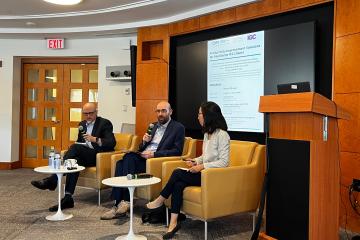
Market access: Connecting firms and entrepreneurs to markets to spur business and job growth

Summary
Across low- and middle-income countries (LMICs), 90 percent of jobs come from private sector firms.1 However, most of these firms are small and relatively unproductive. They tend to hire few workers and struggle to grow over time, held back by many obstacles. Encouraging small firms to develop into successful businesses is a key pathway to fight global poverty by creating jobs and raising people’s incomes from work in the private sector. Unleashing the growth potential of small- and medium-sized enterprises (SMEs) may also boost overall economic efficiency and output.
Governments, international aid groups, NGOs, and other institutions have been trying to help small firms in LMICs grow by offering them access to microcredit, business training, and consulting services, and by skilling workers. These approaches all give firms knowledge or resources to produce more, raise profits, and hire more workers. However, these interventions have had modest effects on firm growth and job creation. This suggests that firms face constraints on the demand side, that is, lacking buyers of their goods and services, which limit growth. Frictions in markets—such as a lack of information or the skills required to find buyers or sellers—can be widespread, and reducing such frictions and thus improving market access holds promise for helping firms in LMICs grow.
A wide range of organizations are already facilitating market access in different ways. These include multinational companies that source goods and services from local firms, technology companies that link businesses to digital markets, and governments doing everything from road building to industrial policy. These efforts are large investments, and it is important to understand their impacts. In 2022, net foreign direct investment (by multinational firms) into low- and middle-income economies totaled US$522 billion.2 Meanwhile, more than 57 countries had set up trade promotion organizations to promote exports.3
A review of 15 randomized evaluations[2][3][4][5][6][8][9][10][11][12][13][14][15][17][18] and 4 quasi-experimental studies[1][7][16][19] shows that market access interventions increased firm revenues, profits, and product quality in various industries and countries. It also helped local firms learn from foreign buyers and from peer firms in ways that increased the firms’ productivity,[5][10] and improved the well-being of workers and households.[9][16][12] The main market access strategies included: 1) training entrepreneurs and managers in marketing skills,[2][3][13] 2) linking firms with other firms[5][10][4][17] and encouraging more participation in formal tender processes,[13][11] and 3) providing digital and physical infrastructure to improve market access for many firms at once.[6][8][12] All of these methods often lifted firm performance, implying that market access is generally a promising approach to private sector development. However, policymakers should also consider implementation quality and complementary programs to support smaller firms, start-ups, and women entrepreneurs. Future research would be valuable to better understand how market access interventions work, how to target firms, whether any gains come at the expense of nontargeted firms, and when these interventions can improve not just sales and profits but also job creation, job quality, productivity gains, and other outcomes.
Supporting evidence
Market access increased firms’ business performance considerably. This was true whether new sales came from foreign buyers and exports,[5][19] multinational corporations in the same country,[1] large domestic firms, or government contracts.[13] Research shows that demand from export markets and foreign customers improved the business performance of firms in LMICs by large margins.[5][1] In Egypt, offering small rug makers a chance to export rugs to clients in the United States and Europe increased firms’ profits by 16–26 percent.[5] In Costa Rica, a quasi-experimental study found that after SMEs began supplying to multinational corporations, they were likely to employ more workers, sell more to other firms, and achieve higher productivity four years later.[1]
Market access interventions that encouraged firms to sell to domestic large buyers, such as the government or corporations, also boosted business growth and sometimes led firms to create more jobs. For example, in Liberia, an NGO offered local SMEs a training program that focused on how to bid and win formal contracts to supply larger organizations in the country. Firms that were offered this program increased the number of buyers they supplied, began selling to new types of buyers, and bid more frequently and won larger value contracts.[13] Three years later, a quarter of these firms were more likely to be operating and employing slightly more workers. In agriculture, a growing body of research similarly examines how connecting farmers to agricultural markets can increase their productivity and profits.[8][18]
Typical firms in LMICs struggle to access markets and find buyers.4 For example, improving small T-shirt exporters’ visibility and how they signal product quality to potential buyers on a global e-commerce platform helped the firms to grow sales.[6] This suggests that the typical firm on the platform needed help to tap into the global market more effectively, even when they were already motivated to sell to export markets and had access to digital infrastructure. Small firms cannot realistically bear the cost of searching for large buyers.[5] Hence, it is important to understand what kinds of institutions are best suited to assist SMEs with market access interventions and which market access methods are most effective.
Market access programs were more effective when they involved larger firms and when they helped firms forge sales contracts rather than just provide information.[5][18] Encouraging firms to start exporting—selling to foreign markets where buyers demand more sophisticated products—is a popular policy. Yet programs intended to make LMIC firms export more do not always work. In Vietnam and Colombia, for example, training initiatives gave the owners and managers of local SMEs information and skills with a focus on exporting. However, they did not result in the SMEs taking up or changing behaviors related to export activities.[15][14] Only larger firms in the Vietnam example exported more afterward, suggesting that even though smaller firms had access to the same information through the training, they did not have enough production capacity or product quality to start exporting.[15]
When export promotion programs directly targeted large firms and involved them as export buyers or intermediaries, smaller firms were more likely to benefit because it led to new sales with these large firms.[5][18] This suggests that if export promotion programs can help forge buyer-supplier relationships and create new sales contracts, they tend to lead to better outcomes for smaller firms. For instance, in another study in Vietnam, dragon fruit producers were offered training on agricultural practices to improve product quality, and some were trained together with exporting firms. After the training, the producers who were trained together with exporting firms were more likely to have contract-based sales, which tend to have higher prices, and were more likely to use the improved practices.[18]
Access to exporting and multinational buyers also often increased productivity,[5][1] worker well-being,[9][16][19] and women’s empowerment.[16] Selling to foreign buyers that tend to demand more sophisticated products can enable smaller firms to become more productive if it leads to knowledge transfers and learning from buyers. In Egypt’s rug manufacturing sector, firms that were offered export orders became able to weave rugs that were higher quality than comparison firms, even when they were making rugs for the domestic market using identical equipment. The quality improvements resulted from “learning-by-exporting”—local producers learned and changed their practices after knowledge transfers and repeat feedback from foreign buyers and their intermediaries.[5]
Three studies found that when garment factories were linked to foreign buyers or multinational corporations, female workers and local households benefited.[9][16][19] In Bangladesh, multinational firms helped enforce laws and improved worker safety at local supplier firms.[9] In this case, multinational buyers formed an alliance to encourage the implementation of legally required workplace safety committees in supplier factories. This increased the local firms’ compliance with the labor law, increasing some measures of factory safety.[9] In a quasi-experimental study in Myanmar, exporting also increased female empowerment as more jobs became available for women and domestic violence dropped in nearby communities.[16] Researchers suggest this was due to women having high-quality job opportunities outside of the household, owing to the mostly female and better-managed garment export sector workforce.[16]
At the firm level, two main methods of improving market access are: 1) teaching entrepreneurs and managers marketing skills,[2][3][13] and 2) fostering firm-to-firm links.[5][10][4][17] Both helped smaller and younger firms grow. There are a few different types of programs directed at firms to help ease their market access. One type is marketing or “seller-ship” trainings, which aim to increase firms’ ability to sell by giving entrepreneurs and managers skills to win contracts and secure more sales. In South Africa, Nigeria, and Liberia, providing marketing skills improved small firms’ survival rates, employment, sales, and profits one to three years later.[2][3][13] In Nigeria, helping firms hire or outsource skilled marketing professionals also improved their marketing practices, and it was cheaper than providing business consulting.[3]
A second strategy of matching firms with other firms to build business relationships has often improved business performance because firms engage in information sharing and learning with each other. Evidence covered earlier in this review supports the idea that buyer-supplier ties in global supply chains (vertical links) drive a process of growth and learning that increases smaller firms’ sales, profits, and productivity.[5][1][19][18] Connecting firms in the same geographic markets with their peers (horizontal links) can similarly improve business performance by allowing firms to gain useful information and contacts from each other[10] and team up for new business collaborations.[4] Such programs can be carried out in-person through business associations[10] or online, for example, using a low-cost messaging app.[4] Female entrepreneurs are also more likely to lack business contacts—creating peer networks allowed them to expand business networks in Ghana[4] and Tunisia.[17]
At the market level, new digital markets have improved market access for firms across large geographic areas, but smaller firms sometimes did not gain sales or profits directly.[8][12] Market-level interventions, such as new or upgraded infrastructure like roads or new digital marketplaces, improve market access by allowing many sellers and buyers to link up more cheaply.5 While randomized evaluations of transport infrastructure are uncommon, three recent evaluations of digital markets suggest that access to digital marketplaces had limited benefits for small firms on the platform in terms of revenue, profits, or workers’ income.[6][8][12] For example, on a global e-commerce platform, information barriers and a crowded market made it difficult for small firms to stand out.[6] However, digital market access often increased overall local commerce, which benefited some consumers[12] or farmers who supplied produce to larger traders.[8] These findings suggest that it is important to understand who benefits from interventions such as new infrastructure and digital markets and to consider complementary programs to support smaller local firms.
Preliminary evidence suggests that when governments pursue market access interventions, success depends on how well they implement those strategies[14][7] and on how much businesses trust public institutions.[11] For example, a quasi-experimental study of South Korea’s export promotion agency found that the skills of officials implementing the program affected outcomes. While opening a new export office in a given country usually increased Korean firms’ exports for many years, thus helping the country’s manufacturing firms grow, there was no positive effect when less-skilled officials were in charge.[7] Export promotion often focuses on priority product categories or industries, with ambitious long-term goals, such as creating many jobs, spurring innovations, and improving productivity. For such complex programs, researchers suggest paying attention to implementation choices and quality when it comes to translating export promotion activities into actual export-led firm growth.[14] How well firms trust the government also matters: in Uganda, improving firms’ perceptions about government corruption led firms to bid on and win more government tenders.[11]
More research should test how to conduct market access programs well to attain firm growth and job creation. More evidence is needed, for example, on what types of organizations are best suited to provide effective market access and how to increase the capacity of institutions providing market access. Researchers and policymakers alike should pay attention to the role of private sector supply chains in supporting SME growth. It would also be helpful to identify the best methods and tools to target the right set of firms for industry and export promotion policies. Research should consider both direct and indirect effects and show which types of programs boost productivity versus those that find effects predominantly from business stealing (e.g., supported firms selling at the expense of nonsupported firms). Finally, more data and research should inform how to design digital platforms, government procurement systems, and access to infrastructure to enhance the entry of women, youth, and other disadvantaged entrepreneurs.
Abdul Latif Jameel Poverty Action Lab (J-PAL). 2024. "Market Access: Connecting Firms and Entrepreneurs to Markets to Spur Business and Job Growth." J-PAL Policy Insights. Last modified September 2024.
World Bank. 2012. World Development Report 2013: Jobs. Washington, DC: World Bank. page xiii.
Alfaro-Ureña, Alonso, Isabela Manelici, and Jose P. Vasquez. 2022. “The Effects of Joining Multinational Supply Chains: New Evidence from Firm-to-Firm Linkages.” Quarterly Journal of Economics 137, no. 3: 1495–1552. Research Paper
Anderson, Stephen J., Rajesh Chandy, and Bilal Zia. “Pathways to Profits: Identifying Separate Channels of Small Firm Growth through Business Training.” World Bank Policy Research Working Paper #7774, July 2016. Research Paper
Anderson, Stephen J. and David McKenzie. 2022. “Improving Business Practices and the Boundary of the Entrepreneur: A Randomized Experiment Comparing Training, Consulting, Insourcing, and Outsourcing.” Journal of Political Economy 130, no. 1: 157–209. Research Paper
Asiedu, Edward, Monica Lambon-Quayefio, Francesca Truffa, and Ashley Wong. “Female Entrepreneurship and Professional Networks.” Working Paper, April 2023. Research Paper | J-PAL Evaluation Summary
Atkin, David, Amit K. Khandelwal, and Adam Osman. 2017. “Exporting and Firm Performance: Evidence from a Randomized Experiment.” Quarterly Journal of Economics 132 (2): 551–615. Research Paper | J-PAL Evaluation Summary | J-PAL Blog
Bai, Jie, Maggie Chen, Jin Liu, Xiaosheng Mu, and Daniel Yi Xu. “Search and Information Frictions on Global E-Commerce Platforms: Evidence from AliExpress.” NBER Working Paper #28100, November 2020. Research Paper
Barteska, Philipp and Jay Euijung Lee. “Bureaucrats and the Korean Export Miracle.” Working Paper, July 2024. Research Paper
Bergquist, Lauren Falcao, Craig McIntosh, and Meredith Startz. “Search Costs, Intermediation, and Trade: Experimental Evidence from Ugandan Agricultural Markets.” Working Paper, February 2024. Research Paper | J-PAL Evaluation Summary
Boudreau, Laura. 2024. “Multinational Enforcement of Labor Law: Experimental Evidence on Strengthening Occupational Safety and Health (OSH) Committees.” Econometrica 92, no. 4 (July): 1269–1308. Research Paper | J-PAL Evaluation Summary
Cai, Jing and Adam Szeidl. 2018. “Interfirm Relationships and Business Performance.” Quarterly Journal of Economics 133, no. 3: 1229–1282. Research Paper | J-PAL Evaluation Summary
Colonnelli, Emanuele, Francesco Loiacono, Edwin Muhumuza, and Edoardo Teso. “Do Information Frictions and Corruption Perceptions Kill Competition? A Field Experiment on Public Procurement in Uganda.” NBER Working Paper #32170, February 2024. Research Paper
Couture, Victor, Benjamin Faber, Yizhen Gu, and Lizhi Liu. 2021. “Connecting the Countryside via E-Commerce: Evidence from China.” American Economic Review: Insights 3, no. 1: 35–50. Research Paper
Hjort, Jonas, Golvine De Rochambeau, Vinayak Iyer, and Fei Ao. “Informational Barriers to Market Access: Experimental Evidence from Liberian Firms.” NBER Working Paper #27662, April 2024. Research Paper | J-PAL Evaluation Summary
Iacovone, Leonardo, David McKenzie, and Rachel Meager. “Bayesian Impact Evaluation with Informative Priors: An Application to a Colombian Management and Export Improvement Program.” Work Bank Policy Research Working Paper #10274, January 2023. Research Paper
Kim, Yu Ri, Yasuyuki Todo, Daichi Shimamoto, and Petr Matous. 2018. “Are Seminars on Export Promotion Effective? Evidence from a Randomised Controlled Trial.” The World Economy 41, no. 11: 2954–2982. Research Paper
Molina, Teresa and Mari Tanaka. 2023. “Globalization and Female Empowerment: Evidence from Myanmar.” Economic Development and Cultural Change 71, no. 2: 519–565. Research Paper
Münch, Florian, Fabian Scheifele, and Amira Bouziri. “Stronger Together: Promoting Export through Female-Only SME Consortia.” Working Paper, August 2023.
Park, Sangyoon, Zhaoneng Yuan, and Hongsong Zhang. 2023. “Technology Training, Buyer-Supplier Relationship, and Quality Upgrading in an Agricultural Supply Chain.” Review of Economics and Statistics 1–46. Research Paper
Tanaka, Mari. 2020. “Exporting Sweatshops? Evidence from Myanmar.” Review of Economics and Statistics 102, no. 3: 442–456. Research Paper
Related Content

J-PAL partners with the IFC and IGC to discuss global supply chains, sustainability, and research collaboration

Jobs and Opportunity Initiative commits first round of funds for research on entrepreneurship and enterprise development
